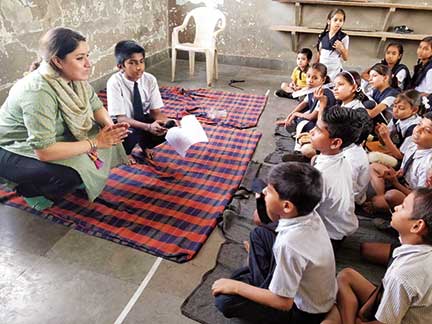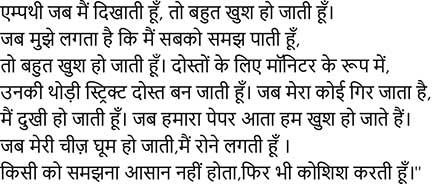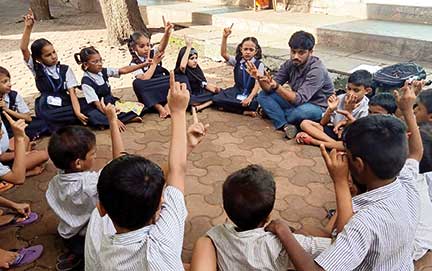Shahbaan Shah
Azul Terronez (educator, entrepreneur and writing coach) in his TED talk, ‘What makes a good teacher great’, says, “When I asked this question, often times I heard this answer: ‘a great teacher loves to teach.” Seventy per cent of the time, the quote or answer that followed this answer was ‘a great teacher loves to learn’. The reason this is significant is that the students don’t see this happening. They don’t see teachers learning in front of them. They see them teaching but they wish they would learn along with them.”
When, Apni Shala started its journey in 2013 with a vision to help build social and emotional competencies among students, we often engaged with these questions – what do we need to know about students, their lives and their ways of being so that we can facilitate their learning better?
In our work, we realized that to build social skills and emotional resilience in students, it was imperative to also alter the systems around them such that their life stories and their voices can become an integral part of the teaching-learning processes. In the last six years of ongoing development and research, social emotional learning finally took shape at Apni Shala in a way that it is informed by Narrative Practices – a postmodern therapy practice, diversity and inclusion, growth mindset, and constructivist learning theory.
This has helped create classrooms (and many a time, out of classroom learning spaces) that are flexible, inviting and safe for students to bring their life-stories into the conversations and development processes. While such stories make learning come alive, they also provide incredible pedagogical support for the facilitators to explore new ways of the teaching-learning processes. In this exploratory piece, allow me to take you through some classroom conversations from the classrooms that my colleagues and I facilitate for social and emotional learning of young people in Mumbai’s municipal schools.
Inviting the context into conversations
 “In a 5th grade class, while facilitating a session on how communication differs as the relationship changes, we were playing Pictionary. I gave the teacher a relatively tough word to draw and tried to see how children communicate with the teacher. While the teacher was drawing, everyone was relatively quiet, answering politely but somewhat hesitantly. After several attempts, they could not guess the word and it was passed on to the next group. But the moment one of the students came to draw the same word, the feel of the entire classroom changed. They were now competing, screaming, rejoicing and answering,” writes Krutika Khare, Programme facilitator with Apni Shala. She mentions that she could see that the way of communicating in these two incidents was different. Changing or modifying the lesson plan and getting the teacher to participate helped the students understand how we communicate differently with different people. She adds, “When I asked the students why they were so energetic and engaged when their friend had his turn,” they replied, “Didi, sir ko hum respect karte hai aur woh badhe hai humse aur Ali toh hamara dost hai isiliye alag logon se alag tarike se baat karte hai.” (Didi, sir is older than us and we respect him but Ali is our friend. This is the way we talk to him on a daily basis.)
“In a 5th grade class, while facilitating a session on how communication differs as the relationship changes, we were playing Pictionary. I gave the teacher a relatively tough word to draw and tried to see how children communicate with the teacher. While the teacher was drawing, everyone was relatively quiet, answering politely but somewhat hesitantly. After several attempts, they could not guess the word and it was passed on to the next group. But the moment one of the students came to draw the same word, the feel of the entire classroom changed. They were now competing, screaming, rejoicing and answering,” writes Krutika Khare, Programme facilitator with Apni Shala. She mentions that she could see that the way of communicating in these two incidents was different. Changing or modifying the lesson plan and getting the teacher to participate helped the students understand how we communicate differently with different people. She adds, “When I asked the students why they were so energetic and engaged when their friend had his turn,” they replied, “Didi, sir ko hum respect karte hai aur woh badhe hai humse aur Ali toh hamara dost hai isiliye alag logon se alag tarike se baat karte hai.” (Didi, sir is older than us and we respect him but Ali is our friend. This is the way we talk to him on a daily basis.)
When they know more than what the teachers bring to the classroom, what do we do? Honour their knowledge!
Aditi Ganguly, another facilitator at Apni Shala, shares an experience with her grade 5 students. “I was facilitating a module on emotions and I said, “What do we feel but can’t see?” They replied quickly: “Bhavnayein (emotions).” We began the session with an icebreaker activity where they had to emote a feeling with voice modulation, expression, and actions. With their energy and giggles, it was evident that they were enjoying the activity. Moving forward I told the students that we would be watching a video next. Shubham, one of the students, requested politely, “Didi, can I share the emotion that I felt right now?” I said yes, please. He answered, “When you came into the class I felt happy, but when you said that we will be talking about emotions today, I felt sad as it reminded me of Bhaiya (a previous year facilitator with the same group) because we discussed this with him as well. As the activity went on, I again felt happy.” Imran said, “Didi can I also share something? I recently felt jealous when my friend shared his pencil with a new boy in class.” Gradually, almost all my students asked me if I could show the video a little later, since they each wanted to share one emotion that they had recently felt and what they had done about it. An hour later, I was carrying 25 different stories of various emotions. The students and their reflections were more meaningful than any video could ever have been!”
When they rewrite the curriculum…
In one of my own grade 5 groups, while facilitating a session on Empathy, Rashida, one of my students, asked, “Bhaiya, can you just tell me what is the literal meaning of empathy?”
I explained to her the meaning of empathy with an example from one of my 5th grade classes at a different school where I facilitate. There, a student said, “Bhaiya, if you are happy and I am sad, then don’t hide your happiness. Because I know what happiness is and it’s ok to be happy.” Next week, she came to the class with this beautiful poem:

(When I act with empathy, I feel very happy.
when I feel I am able to understand others, I feel very happy.
In the form of a monitor, I become a little strict friend to my friends.
When someone falls, I feel sad.
When our papers come, we feel happy.
When I lose something, I start crying.
to understand someone is not easy, but I still try.)
That day, the poem became the syllabus for my class to unpack the concepts of empathy. Together as a team, we tried to understand in which line the poet tried to show empathy and how it looks. Some of my students answered, “Bhaiya, when she says that we should understand and respect each other, that’s empathy!”
Emily Jane Styles writes in her paper, ‘Curriculum as Windows and Mirror’, “All students deserve a curriculum that mirrors their own experiences back to them, upon occasion thus validating it in the public world of the school. But curriculum must also insist upon the fresh air of windows into the experience of others who also need and deserve the public validation of the school curriculum. Differences as well as similarities exist. The mathematics and the linguist see the world in different ways. One is not superior to the other, a balanced education encompasses both where students or anybody else can look into self and the world around us.”
This reminds me of how Rashida’s bringing a mirror into the class became a window for others to look at various realities through many similarities (mirrors) and differences (windows). This also allowed students to become co-creators of the curriculum, when it was informed by their lives, agency and choices. I can never forget the smile on Rashida’s face that day, when she saw her poem being used as an official text in the classroom, with other students reading it as they would read any other poet’s piece.
 When experiences become part of learning…
When experiences become part of learning…
“While taking a session on cultural diversity with grade 6, we were doing a role play in which the students had to enact practices that we see/do in different religions, i.e., Islam, Hinduism, Sikhism and Christianity. When we opened the circle for discussion, students shared how they show respect in their religion. Listening to their examples, it struck me that most of my students followed Buddhism. As the conversations moved forward, we began discussing the Bhima Koregaon case. After a thought-provoking and reflective discussion, one of my students highlighted the fact that nobody likes to be dominated or suppressed by anyone else. My students contextualized a session where I wanted to highlight how we should respect all alike, and the outcome was more than I ever thought it would be,” writes Abhijeet Dhurve.
These conversations have made facilitators realize the power of stories from the students’ lives. Where do students live? What religion or culture do they follow? What class do they come from? What is going on in their lives? And many more contexts that we are yet to explore. The learning objective in our session is achieved when students are able to connect to the learning in their lives and that’s why it is important to bring out stories from the students’ context.
Being an alumni fellow and now a facilitator at Apni Shala, I have witnessed how we cultivate and nourish freedom in our classrooms with responsibility. This has enabled us to help our students open up in the classrooms, where they can talk about things that matter to them. This has also helped me realize how important it is to let students talk than to teach what I have planned. I wonder, then, as educators, should we start planning for our students to share, ideate, lead and facilitate their own learning?
The question remains, how do we make it an organizational practice?
How do we make it possible?
At Apni Shala, facilitators receive ongoing development opportunities, coaching, mentoring and supervision to develop their knowledge, skills, and mindset to co-create inclusive, diverse, constructive and growth-oriented learning spaces with young people. These opportunities help facilitators develop active listening skills. These pieces of training help facilitators construct spaces of student learning which offer agency to the child. This also allows us to weave students’ voices into conversations and the context of what they are sharing and why.
While writing this article and listening to all the stories from the facilitators, I was reminded of a question I had heard somewhere, “Who holds the pen?” Holding a pen is very important as the holder denotes his/her understanding of a student’s life and voice.
Here are stories of what happens when students hold their own pens, rather than anyone else holding pens for them.
Once the pen is in the hand of the person whose story is being narrated, the visibility of lived experiences becomes more transparent and true joy comes out of it. Stories abound, but the onus is on us to share the story. As educators, parents, students and mentors which story do you want to narrate or listen to?
The author is a programme facilitator with Apni Shala Foundation. He works with children and teachers from Mumbai’s municipal schools to facilitate social and emotional learning from grades 4 to 8. He also assists in R&D initiatives at Apni Shala. He can be reached at shahbaan.apnishala@gmail.com.
